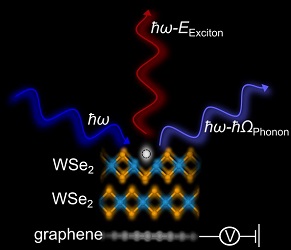Master's Thesis in Raman Spectroscopy of Atomic Quantum Defects
The Nanomaterials Spectroscopy and Imaging Group in collaboration with nanotech@surfaces Lab is offering a Master's Project in Raman spectroscopy of atomic quantum defects.
We are looking for a highly motivated candidate with an experimental background and interest in solid state physics, nanoscience and Raman spectroscopy who wants to pursue cutting-edge research at a world-class level.

Two-dimensional (2D) materials have gained significant research attention due to their promising electric, optoelectronic, and quantum properties. One stereotypical family of 2D semiconductors are transition metal dichalcogenides (TMDCs) that bring further electronic miniaturization within reach in short term and might enable quantum phenomena beyond cryogenic in the long term. The fundamental limit of miniaturization is a single atom. Single atomic substitutions or vacancies, so-called defects, particularly interesting because of their atomically precise character and their quantum properties. To interface these atomic defects with existing electronics, conducting 2D materials such as graphene are necessary. The study the coupling of different 2D TMDCs and graphene is an active field of research. How these defects influence the electronic, optical and vibrational properties of the host material and how we can control these with graphene is a fundamentally interesting and technological relevant question.
During your Master's project, you will learn how to introduce defects selectively into 2D WSe2 via ion bombardment in ultra-high vacuum. We will characterize the defect density and properties in a state-of-the-art scanning tunneling microscope (STM). You will be trained to perform Raman spectroscopy and photoluminescence measurements, that provide information about vibrational and optical properties, respectively. Correlating these far-field measurement with atomic STM measurement, we can correlate electronic, vibration and optical properties of these defects. Comparing WSe2 on graphene to an insulating substrate lets us estimate how these properties change when being contacted.
Required qualifications include a Bachelor degree in physics, chemistry, materials science, or equivalent with preferably background in solid-state physics or nanoscience.
The position is available starting December 2024 or upon agreement.
Send your CV with a brief motivation letter to Dr. Mirjana Dimitrievska mirjana.dimitrievska@empa.ch , and Laric Bobzien Laric.Bobzien@empa.ch .

